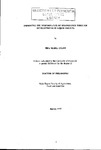IMPROVING THE PERFORMANCE OF WEANER PIGS THROUGH DEVELOPMENTS IN LIQUID FEEDING
| dc.contributor.author | GEARY, TINA MARIA | |
| dc.contributor.other | Faculty of Science and Engineering | en_US |
| dc.date.accessioned | 2013-11-21T14:24:39Z | |
| dc.date.available | 2013-11-21T14:24:39Z | |
| dc.date.issued | 1997 | |
| dc.identifier | NOT AVAILABLE | en_US |
| dc.identifier.uri | http://hdl.handle.net/10026.1/2793 | |
| dc.description.abstract |
A programme of work was undertaken to assess the efficacy of a new automated ad libitum feed delivery system for newly weaned pigs; to investigate the effects of liquid feeding on their performance and to explore the possibilities for reducing diet cost by using lower cost liquid components. A series of 28 day feeding trials was conducted using pigs weaned at 24 ± 4 days and fed ad libitum on liquid diets. Compared with pigs fed dry diets, liquid feeding increased feed intake by 109 ± 10 g dˉ¹ (P<0.001) and daily gain by 57± 14 g dˉ¹ (P<0.001). Pig growth and feed conversion ratio was not significantly influenced by dry matter content over the range of 255 - 149 g DM kgˉ¹. However, diets containing less than 220 g DM kgˉ¹ increased effluent output per kg of liveweight gain. Within the liquid feed system a natural lactic acid fermentation occurred which reduced diet pH ≤ 4.0 and inhibited the growth of coliform bacteria. Pigs fed diets in which pH was reduced to ≤ 4.0 by acidification with either lactic acid or Pediococcus acidilactici had daily gains of 496 and 474 ± 17 g dˉ¹ and feed conversion ratios of 1.11 and 1.15 ± 0.06 respectively. A series of laboratory studies was conducted with the aim of upgrading and controlling fermentation of food industry liquid residues for use in liquid diets for weaners. Steeping was investigated as a method for reducing glycoalkaloid levels in reject raw potatoes. A combination of natural fermentation and hydrolysis reduced the levels of α-solanine by 16.6 mg kgˉ¹ (35%) and α-chaconine by 28.7 mg kgˉ¹ (51%) respectively. Diets based on the food industry liquid residues (Whey, 'C'-Starch and Greenwich Gold), were either allowed to ferment naturally or inoculated with Enterococcus faecium or Pediococcus acidilactici. Inoculation with either Enterococcus faecium or Pediococcus acidilactici did not result in a significant difference in the final pH of the diets or in the final populations of microorganisms examined compared with the control. The series of studies demonstrated the potential for improving weaner pigs performance using fermented liquid diets. However, it highlighted the need for further studies to obtain a greater degree of control over fermentation patterns. | en_US |
| dc.language.iso | en | en_US |
| dc.publisher | University of Plymouth | en_US |
| dc.title | IMPROVING THE PERFORMANCE OF WEANER PIGS THROUGH DEVELOPMENTS IN LIQUID FEEDING | en_US |
| dc.type | Thesis | |
| plymouth.version | Full version | en_US |
| dc.identifier.doi | http://dx.doi.org/10.24382/4427 |
Files in this item
This item appears in the following Collection(s)
-
01 Research Theses Main Collection
Research Theses Main


